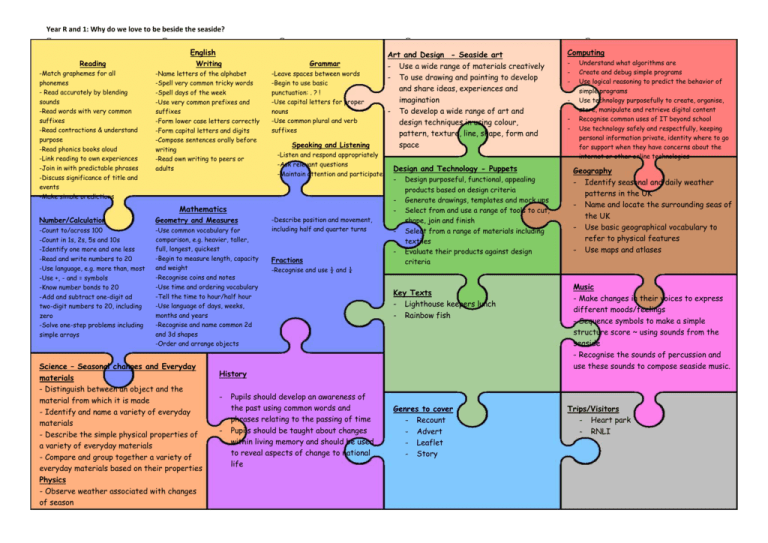Seaside - Loddington School
advertisement

Year R and 1: Why do we love to be beside the seaside? English Reading -Match graphemes for all phonemes - Read accurately by blending sounds -Read words with very common suffixes -Read contractions & understand purpose -Read phonics books aloud -Link reading to own experiences -Join in with predictable phrases -Discuss significance of title and events -Make simple predictions Writing Grammar -Name letters of the alphabet -Spell very common tricky words -Spell days of the week -Use very common prefixes and suffixes -Form lower case letters correctly -Form capital letters and digits -Compose sentences orally before writing -Read own writing to peers or adults -Leave spaces between words -Begin to use basic punctuation: . ? ! -Use capital letters for proper nouns -Use common plural and verb suffixes Speaking and Listening -Listen and respond appropriately -Ask relevant questions -Maintain attention and participate Design and Technology - Puppets - Mathematics Number/Calculation Geometry and Measures -Count to/across 100 -Count in 1s, 2s, 5s and 10s -Identify one more and one less -Read and write numbers to 20 -Use language, e.g. more than, most -Use +, - and = symbols -Know number bonds to 20 -Add and subtract one-digit ad two-digit numbers to 20, including zero -Solve one-step problems including simple arrays -Use common vocabulary for comparison, e.g. heavier, taller, full, longest, quickest -Begin to measure length, capacity and weight -Recognise coins and notes -Use time and ordering vocabulary -Tell the time to hour/half hour -Use language of days, weeks, months and years -Recognise and name common 2d and 3d shapes -Order and arrange objects Science – Seasonal changes and Everyday materials - Distinguish between an object and the material from which it is made - Identify and name a variety of everyday materials - Describe the simple physical properties of a variety of everyday materials - Compare and group together a variety of everyday materials based on their properties Physics - Observe weather associated with changes of season Art and Design - Seaside art - Use a wide range of materials creatively - To use drawing and painting to develop and share ideas, experiences and imagination - To develop a wide range of art and design techniques in using colour, pattern, texture, line, shape, form and space -Describe position and movement, including half and quarter turns Fractions -Recognise and use ½ and ¼ - Design purposeful, functional, appealing products based on design criteria Generate drawings, templates and mock ups Select from and use a range of tools to cut, shape, join and finish Select from a range of materials including textiles Evaluate their products against design criteria Key Texts - Lighthouse keepers lunch - Rainbow fish History - - Pupils should develop an awareness of the past using common words and phrases relating to the passing of time Pupils should be taught about changes within living memory and should be used to reveal aspects of change to national life Genres to cover - Recount - Advert - Leaflet - Story Computing - Understand what algorithms are Create and debug simple programs Use logical reasoning to predict the behavior of simple programs Use technology purposefully to create, organise, store, manipulate and retrieve digital content Recognise common uses of IT beyond school Use technology safely and respectfully, keeping personal information private, identity where to go for support when they have concerns about the internet or other online technologies Geography - Identify seasonal and daily weather patterns in the UK - Name and locate the surrounding seas of the UK - Use basic geographical vocabulary to refer to physical features - Use maps and atlases Music - Make changes in their voices to express different moods/feelings - Sequence symbols to make a simple structure score ~ using sounds from the seaside - Recognise the sounds of percussion and use these sounds to compose seaside music. Trips/Visitors - Heart park - RNLI











